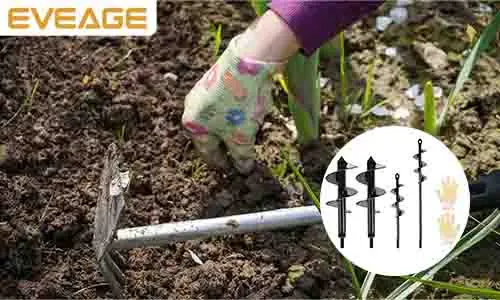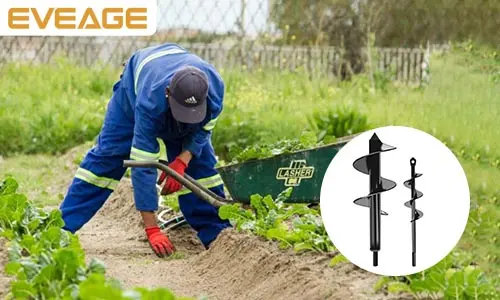Introduction
When you’re drilling a hole in concrete, the size of your bit or auger will depend on a number of factors.
For example, if you’re trying to install a 4×4 post into concrete, then you’ll need a larger bit than if you were just making holes for wires or pipes. Or if you are creating holes for fence posts, then the diameter of your drill bit should be smaller than if you were trying to install posts that require deeper foundations or standoffs (because those types of projects would require much larger holes).
Hole size
Once you have decided on your post, the next step is to determine the size of hole you need. The size of your hole is dependent on how large or small your wire will be. You want it to fit snugly but not too tight so that it can’t move around freely.
If you are using a 4 x 4 post for example, then a 3/4 inch bit should work well for drilling out enough space for wire to move freely inside the post without getting caught up in any surrounding wood fibers or pieces (although these may occur if drilling does not go well). If this is not an option or something that doesn’t sound feasible then there are other options such as purchasing pre-drilled posts from places like Lowes or Home Depot where professionals have already drilled them out with power tools such as routers before they sell them off at their stores
Body width
The body width is the diameter of your drill bit. It’s important to know this because it determines how much soil you can remove at once. The wider a bit, the more soil it will remove at one time. Body widths are usually measured in millimeters and may be in either metric or imperial units (the latter being more common).
Maximum cutting diameter
The maximum cutting diameter of a bit is the diameter of the hole you can make with that bit. It’s measured by measuring both the diameter of the hole you want to make, and then measuring the diameter of your bit, and finding out how much bigger or smaller your bit is than your desired hole size.
For example: if you want to drill a 4″ hole in a 4×4 post, but have only a 3″ drill bit on hand… well then! We need to find out what size drill we’re going to need so we don’t end up with an over-sized hole that doesn’t fit our 4×4 post perfectly.
Pilot Point nose
A pilot point, also known as a nose, is the first part of a drill bit that you insert into your material. It helps guide and stabilize it as you drill. The type of nose you use depends on what kind of material you are drilling into. For example, when drilling through soft materials like wood or plastic, it’s best to use a pointed nose because this will help prevent tip breakage. However, if your project requires drilling through hard materials such as concrete or metal then using a cone-shaped pilot point may be more effective for getting through dense materials without causing too much friction between the bit and the surface being drilled.
There are three main types of pilot points available:
-
Steel cones – These are usually used for softer materials like wood or plastic since they’re very durable but not sharp enough to cut through harder surfaces like glass or stone easily;
-
Carbide cones – These types of cones last longer than traditional steel ones but can still cause some friction with tough surfaces;
-
Pointed noses (also called “spade bits”).
SDS shank
Tools with a SDS shank and SDS Plus shank are designed to be used with a drill that has an SDS or SDS Plus chuck. The difference between the two is that the bit can only be used in one direction, making it easier to hold onto.
A tool with an SDS shank can only be used in an impact driver with a socket attachment, but cannot be attached directly to an electric drill. It must first be inserted into the socket attachment of an impact driver before it can be used on your project.
Material type
Material Type
The material of a hole is also important. A hole in wood, metal or concrete requires different tools and techniques than one drilled into soil or glass. In some cases you’ll need to drill through rubber or plastic to reach your target.
Material thickness
How thick the material is, and what kind of drill bit you use, will determine the size of hole you need to make. In general, the thicker your material is, the bigger your hole will be.
If you’re working with a sheetmetal that’s 3/16″ thick or less—such as 16-gauge steel—and using a standard twist drill (a type of masonry bit), we recommend drilling a 1/2″ dia. hole. A larger diameter will allow for more room for mounting hardware on both sides of the post and provide extra anchoring strength for your fence system.
For thicker materials like 12-gauge steel sheets or 14-gauge curved sections (like those used in FenceMaxx® Designer Style Kits), we suggest using a 5/8″ diameter twist drill bit; this should provide ample space for mounting hardware while keeping things sturdy enough to withstand high winds or other forces acting against it during installation or regular use.
Number of flutes
The number of flutes on your bit will depend on the material you are drilling. A single-flute bit works for softer materials like wood, but for harder materials such as metals and stone, having more than one flute is optimal because it allows the bit to cut faster. This is because each flute acts as a separate cutting surface which allows for faster chip removal from the material being drilled.
The downside to having multiple flutes is that they add weight and cost to your tool. So if you only need to drill occasionally and don’t mind compromising some performance with a single-fluted bit, then go ahead!
Drill Bit Length
You can’t just use any drill bit to drill a 4×4 post. The length of the drill bit depends on the material you are drilling, the size of the hole you are drilling and how deep you want it. It’s important to choose the right length for your project so that you don’t end up burning out your tool or making mistakes later on.
The size of the bit or auger you should use to drill a hole depends on a number of factors
The size of the hole you need will depend on a number of factors:
-
The size of the post
-
The type of soil in your area (there are many different types, but for this example we’ll assume that it’s clay)
Conclusion
We hope that we’ve helped you understand how to calculate the size of drill bit for your project. It’s important to know what kind of material you are drilling into, how thick it is and what the maximum cutting diameter is before deciding on a drill bit size. If you have any more questions please feel free to contact us at [email protected] or visit our website at https://www.eveagetool.com/ where our team will be happy assist you with choosing the right size hole for your project!




